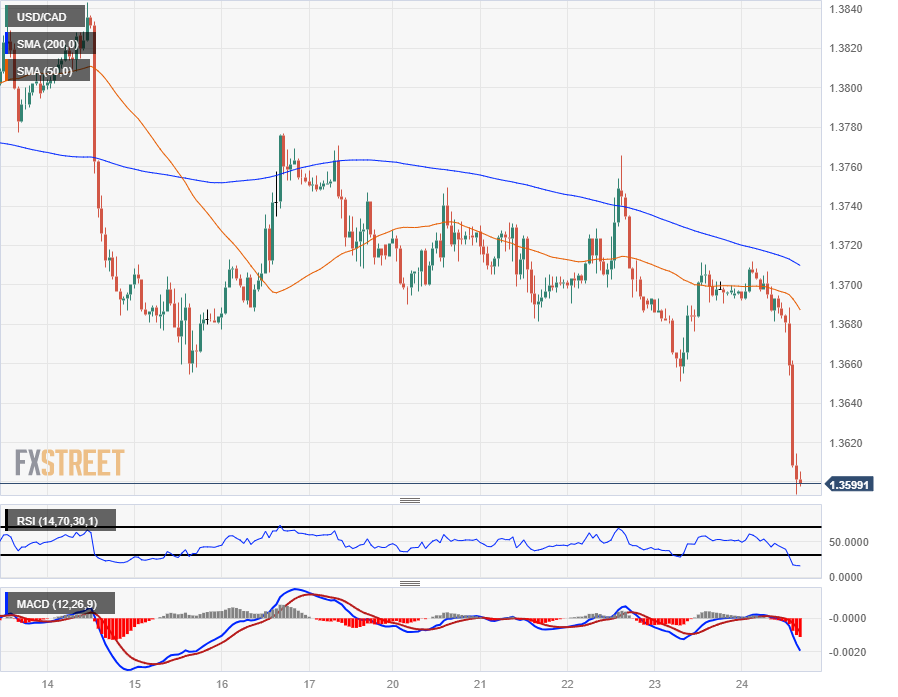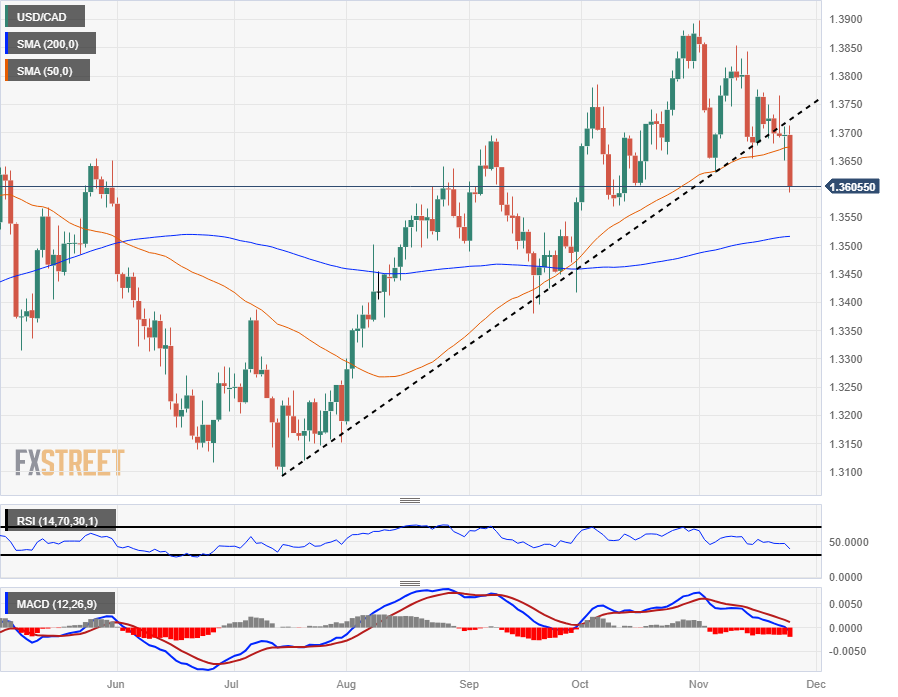The Canadian Dollar found its highest bids in nearly six weeks on data beats.
Retail Sales in Canada gave a surprise 0.6% jump in September.
The Loonie is firmer across the board on Friday.
The Canadian Dollar (CAD) found some bullish momentum in the latter half of Friday’s trading session, taking the USD/CAD pair down into the 1.3600 region.
A better-than-expected Retail Sales report and a broad market recovery in risk sentiment are bolstering the Loonie against the US Dollar (USD), with the CAD up across the board and the Greenback on the softer side heading into the trading week’s close.
Daily Digest Market Movers: Canadian Dollar finds a rebound, USD/CAD back into 1.3600
The CAD is back in action, climbing against all of the majors on Friday.
Retail Sales within Canada surged 0.6% in September, well above Wall Street’s no-change forecast and walking back August’s -0.1% print.
Core Retail Sales (excluding automobiles, gas station purchases and car parts) still rose 0.2%.
Retail Sales were still up 0.3% in September by volume.
3Q Retail Sales up 0.6%, Retail Sales volume down 0.5% over the same period.
US Purchasing Managers Index (PMI) in November saw a weakening Manufacturing component, injuring the Greenback.
US Composite PMI in November held steady at 50.7 as the Manufacturing and Services components were mixed.
US Manufacturing PMI down from 50.0 to 49.4, missing the forecast of 49.8.
US Services PMI edged higher from 50.6 to 50.8, beating the expected slip to 50.4.
Canadian Dollar price today
The table below shows the percentage change of Canadian Dollar (CAD) against listed major currencies today. Canadian Dollar was the strongest against the US Dollar.
USD
EUR
GBP
CAD
AUD
JPY
NZD
CHF
USD
-0.24%
-0.53%
-0.68%
-0.36%
-0.04%
-0.56%
-0.27%
EUR
0.24%
-0.29%
-0.43%
-0.12%
0.21%
-0.31%
-0.03%
GBP
0.54%
0.28%
-0.13%
0.17%
0.50%
-0.04%
0.28%
CAD
0.68%
0.42%
0.15%
0.32%
0.63%
0.12%
0.41%
AUD
0.36%
0.11%
-0.17%
-0.31%
0.32%
-0.20%
0.09%
JPY
0.03%
-0.21%
-0.53%
-0.64%
-0.32%
-0.54%
-0.21%
NZD
0.58%
0.32%
0.03%
-0.11%
0.20%
0.52%
0.29%
CHF
0.26%
0.01%
-0.28%
-0.41%
-0.11%
0.22%
-0.30%
The heat map shows percentage changes of major currencies against each other. The base currency is picked from the left column, while the quote currency is picked from the top row. For example, if you pick the Euro from the left column and move along the horizontal line to the Japanese Yen, the percentage change displayed in the box will represent EUR (base)/JPY (quote).
Technical Analysis: Canadian Dollar rebounds in the trading week’s eleventh hour, drags USD/CAD back down to 1.3600
The Loonie’s late break sees the USD/CAD challenging the 1.3600 handle, with the pair aimed straight at the 1.3500 target, just past the 200-day Simple Moving Average (SMA).
The pair has decisively broken through the rising trendline from July’s low bids at 1.3100, and technical support from the 50-day SMA has broken through.
Intraday declines in the USD/CAD has hourly candles pulling well away from the near-term mid-ranges, dropping into 1.3600. Any bullish rebounds will be seeing a technical resistance range between the 50- and 200-day SMAs, which are dropping into 1.3680 and 1.3700, respectively.
USD/CAD Hourly Chart

USD/CAD Daily Chart

Risk sentiment FAQs
In the world of financial jargon the two widely used terms “risk-on” and “risk off” refer to the level of risk that investors are willing to stomach during the period referenced. In a “risk-on” market, investors are optimistic about the future and more willing to buy risky assets. In a “risk-off” market investors start to ‘play it safe’ because they are worried about the future, and therefore buy less risky assets that are more certain of bringing a return, even if it is relatively modest.
Typically, during periods of “risk-on”, stock markets will rise, most commodities – except Gold – will also gain in value, since they benefit from a positive growth outlook. The currencies of nations that are heavy commodity exporters strengthen because of increased demand, and Cryptocurrencies rise. In a “risk-off” market, Bonds go up – especially major government Bonds – Gold shines, and safe-haven currencies such as the Japanese Yen, Swiss Franc and US Dollar all benefit.
The Australian Dollar (AUD), the Canadian Dollar (CAD), the New Zealand Dollar (NZD) and minor FX like the Ruble (RUB) and the South African Rand (ZAR), all tend to rise in markets that are “risk-on”. This is because the economies of these currencies are heavily reliant on commodity exports for growth, and commodities tend to rise in price during risk-on periods. This is because investors foresee greater demand for raw materials in the future due to heightened economic activity.
The major currencies that tend to rise during periods of “risk-off” are the US Dollar (USD), the Japanese Yen (JPY) and the Swiss Franc (CHF). The US Dollar, because it is the world’s reserve currency, and because in times of crisis investors buy US government debt, which is seen as safe because the largest economy in the world is unlikely to default. The Yen, from increased demand for Japanese government bonds, because a high proportion are held by domestic investors who are unlikely to dump them – even in a crisis. The Swiss Franc, because strict Swiss banking laws offer investors enhanced capital protection.
Note: All information on this page is subject to change. The use of this website constitutes acceptance of our user agreement. Please read our privacy policy and legal disclaimer.
Opinions expressed at FXstreet.com are those of the individual authors and do not necessarily represent the opinion of FXstreet.com or its management.
Risk Disclosure: Trading foreign exchange on margin carries a high level of risk, and may not be suitable for all investors. The high degree of leverage can work against you as well as for you. Before deciding to invest in foreign exchange you should carefully consider your investment objectives, level of experience, and risk appetite. The possibility exists that you could sustain a loss of some or all of your initial investment and therefore you should not invest money that you cannot afford to lose. You should be aware of all the risks associated with foreign exchange trading, and seek advice from an independent financial advisor if you have any doubts.
>>> Read full article>>>
Copyright for syndicated content belongs to the linked Source : FXStreet – https://www.fxstreet.com/news/canadian-dollar-surges-on-friday-as-canadian-retail-sales-beat-the-street-202311241702































